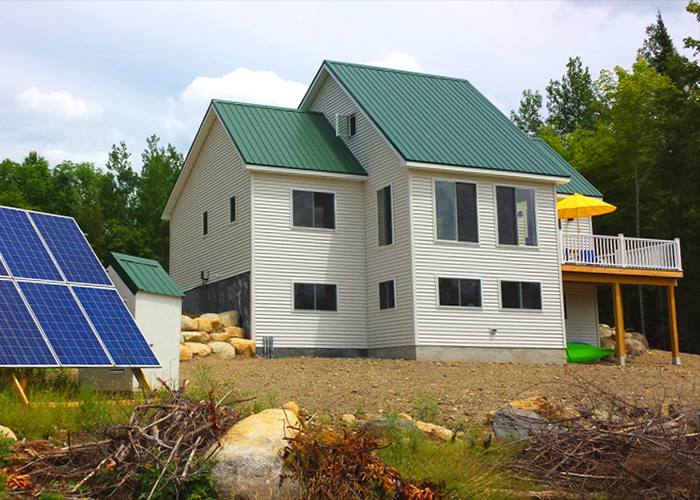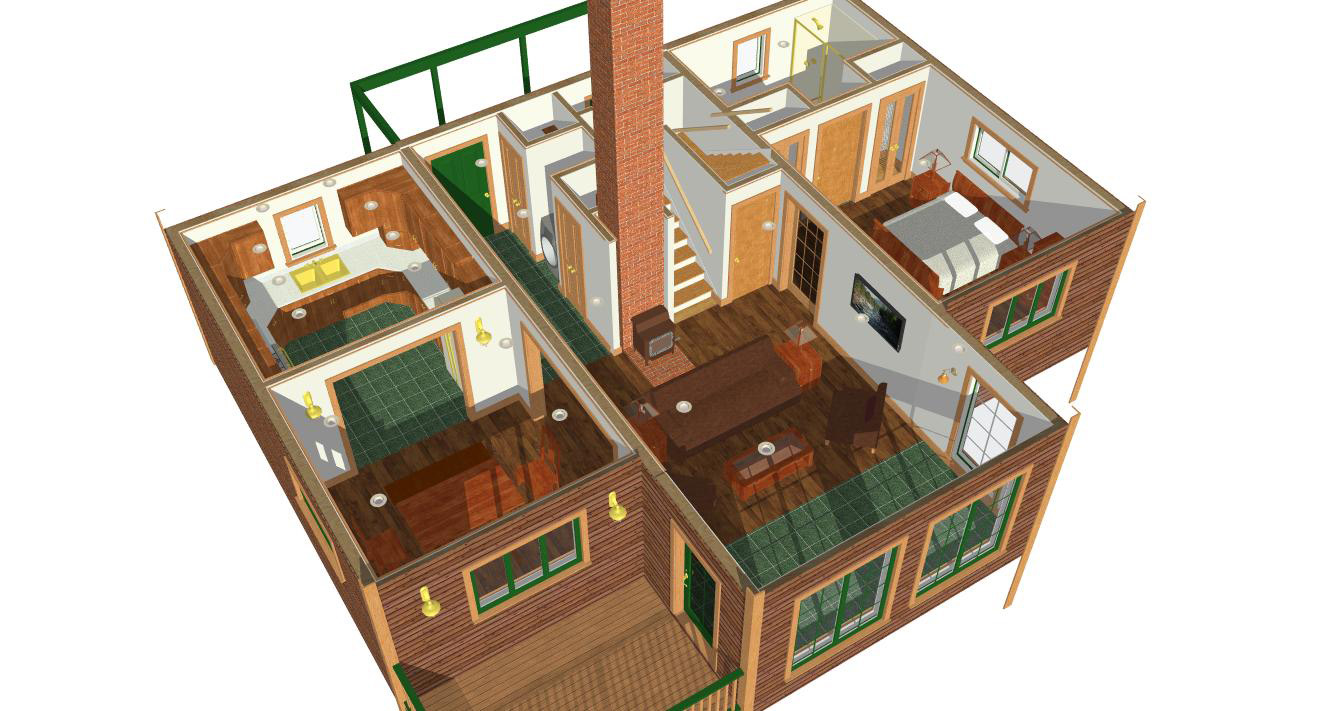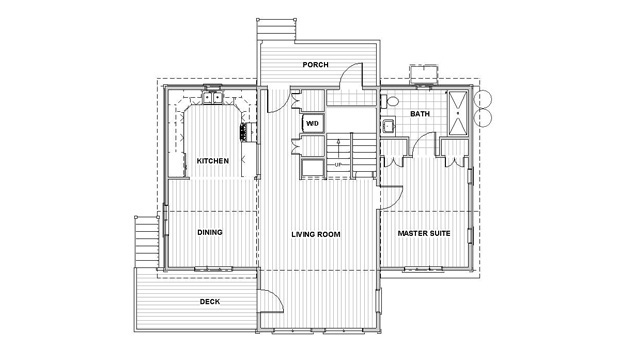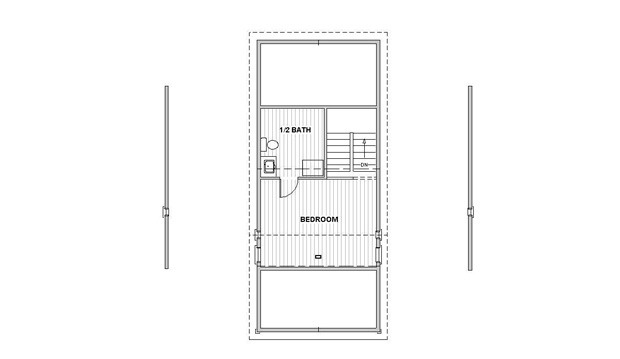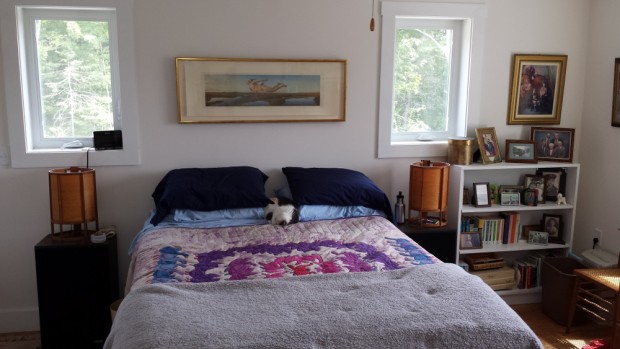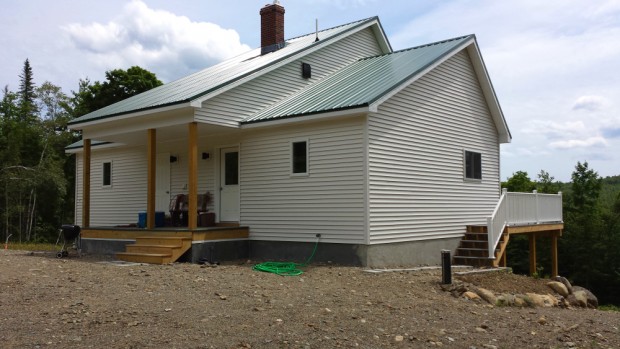SunJazz 1504 2B Solar Cottage
A Luxury Compact!
A retired couple with a land lot that is deep in the woods, far from the power grid, wanted a home that was powered by solar photovoltaics with battery storage. Winters are cold in this location. They have a beautiful view of mountains on the south, where the sun shines. They wanted their master bedroom on the first floor, and a second bedroom in the loft.
This is the house of their dreams with only 1,504 square feet. The south roof is angled ideally for solar panels, hydrothermal or photovoltaic, but they decided to put photovoltaic panels on the ground, where they are east to maintain. They have a wood pellet stove in the basement for backup and supplementary heat, but seldom use it. Their hot water for heat and tap are heated by an electric fired water heater. This house has two bathrooms, a spacious kitchen and dining and living room. They love to start their Summer garden seedlings near the south windows.
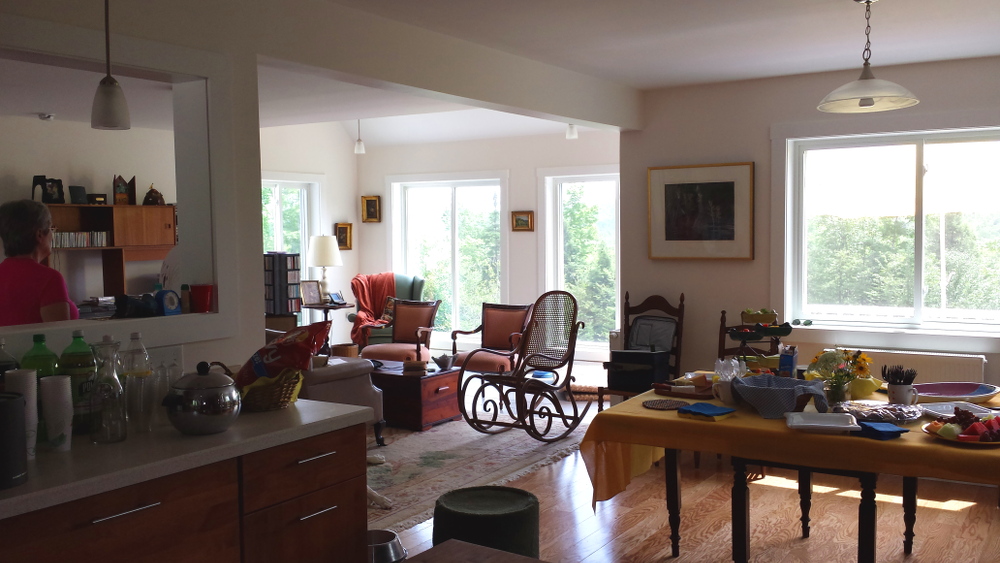
Living Room from Kitchen
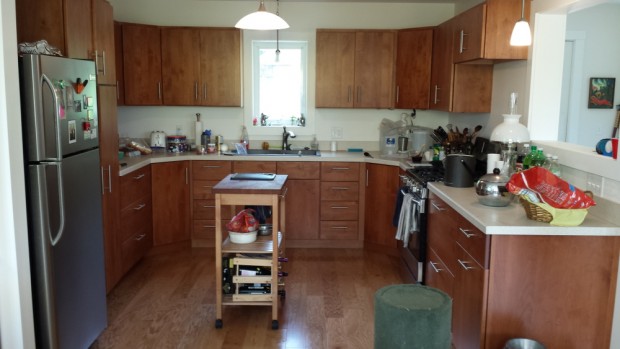
Kitchen
Accommodations
The SunJazz 1,504 design is a one and a half story house with a full basement. The basement is needed for the the utilities, but is also big enough for a full apartment with a finished interior. The first floor is a complete, spacious, one bedroom apartment with a generous handicap-ready bathroom. The front entry has a covered porch that could be enclosed, and has an exterior closet for snow shovels and some winter toys.
In the front entry hallway, there are two closets and a washer-dryer stack. The kitchen has everything anyone would want, and a wall opening to see who is at the door. They even put a wood pellet stove in the living room because the chimney can hold two flues. Part of the living room has an atrium ceiling, for that more spacious feeling. The attic has a second bathroom and a big bedroom that the clients uses for an office or to sleep guests.
Solar Energy System
Every lighting fixture in the house should be fitted for energy saving LED bulbs. All the appliance should have the highest energy conservation rating on the market. It is worth spending the extra dollar for the best appliances because you will save a lot of money over time.
Too many windows in a warm climate make the house hot, and too many windows in a cold climate will lose too much heat. The right balance is almost always based upon a ratio of 10 percent glass to floor area. If the house is 1000 SF, then you can use 100 SF of glass, and 2/3rds of that should be facing south in a cold climate, while facing north in a hot climate.
in 2013, their entire solar energy installation cost a mere $14K, and the prices have dropped substantially since then. Some companies (SolarCity) will install your solar energy system with no money down, and offer a payment plan. When the payments end, you own the system. In Maine, you can get a tax deduction on 1/3 off your solar energy installation costs. Other states have different offers. You could also ask your solar installer about the local benefits of buying a few extra panels and selling power back into the public power grid for credit.
Land
This house was designed for a sloped lot, allowing an exterior door and some windows in the basement. It is hard to find a flat lot in Maine any more. Digging this foundation required a little bit of blasting into granite ledge. For this house, it is also important that your best outdoor scenery is also on the south side of the lot and the entry from the road on the north.
Site Work
If you don’t have electric service, then you are not near city water lines either and you will need a water well. A well can often be drilled for about $5K, but the average cost is $8K once it is all hooked up. You will need a septic tank and leaching field for the waste from your toilet and sinks that will run between $9K and $12K. It is important to include these items in your pricing and planning.
Foundation
If you are on a slope, you are probably above the water table, or have good drainage, which is important for a full basement. You can build this house with steel reinforced 8 inch concrete walls, but I recommend 10 inch walls in climates like Maine where the Winter frost expands the earth and puts a lot of pressure on the walls below grade.
Walls & Insulation
The exterior and plumbing walls are framed with 2×6 studs with fiber batt insulation for an R23 wall in medium climates, or in colder climates, use injected, closed cell Icynene foam [https://www.icynene.com/en-us] to achieve an R37 to R40 wall, or add an inch of rigid foam board to the exterior for an R32. The ceiling and the rafters can both receive batt insulation, rendering as much as an R50 insulation value. I recommend 2 inches of rigid foam against the exterior foundation wall, at least below grade, but preferably the whole exterior. There are stucco finishes available for coating rigid foam board at the foundation level.
Roofing & Siding
I have chosen a metal roof, but you may want to cut the budget with fiberglass. Exterior wall finish siding can be cedar shakes or T-111 or cedar clapboards, hardy board, or even stone veneer. The plumbing is conveniently consolidated along the back left of the house for simpler installation and lower cost.
Interior & Exterior Finish
I would use gypsum wallboard for the interior sheathing, but you might prefer wood panels. There are also different kinds of prefabricated panels that simulate wood, but they tend to be flimsy compared to gypsum wallboard and are not designed to be painted.
The exterior finish could be cedar shakes, like I show on the plan, or cedar clapboard, or T-111, or board and batten, or composite lap siding, or anything you like. If you want to save a little money and avoid having to paint or seal the surface every few years, you could apply vinyl or aluminum siding.
Final Installations & Finishes
Now it is time to install the finish flooring, the baseboards, window and door trims, and any other trim work you desire such as ceiling molding, and add closet poles and shelving, and the pantry cabinets. If you want to save a little more money, you could skip the exterior window trim, but I like the way it looks with trim.
Plumbing & Electrical
The best plumbing pipes these days are made of PVC, polyethylene and vinyl. They are flexible, less likely to freeze, never corrode, and can be installed with much less labor and less expensive materials like copper. All the lamps and outlets and switches are installed during this phase, leaving off the cover plates until the wallboard is installed. There are just the right number of lights, switches and outlets in this house.
Construction Cost
In Maine, the average cost of building this house will be $175 per square foot. At 1,504 square feet, this house can be built by a general contractor for strong>$264,000 including the well and the septic system. With a 5 percent interest rate for a 25 year mortgage, a monthly mortgage payment will be about $1,543. If you negotiate a discount for buying your materials in bulk and choose modestly priced components, and maybe contribute some labor, then construction costs can be reduced.
Policy
Construction plans at SolarScopia provide a lot of the information needed to build each design. Not every necessary decision has been illustrated in the plans. Some decisions must be researched and made by the client/builder team in the field prior to construction. SolarScopia cannot and does not accept responsibility for the results of using our plans to build. Find a smart and honest builder and you should do well.

